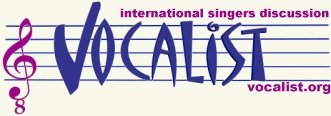Dear List:
While I only comment occasionally, I read many of the posts and have
been a list participant for several years.
Lloyd Hanson very succintly summarized one description of vocal
registration: "In chest voice all of the layers of the vocal folds
are involved in some form of oscillation, in middle voice somewhat
less of the vocal muscle is involved and in head voice primarily the
vocal ligament/mucosal membrane is in oscillation. .... falsetto (is)
... a different configuration of the vocal folds from that mentioned
above."
COMMENT:
I struggle to apply these ideas to my own voice as well as what I
hear in others. Some specifics:
I assume that for a voice like mine (say tenor), Prof. Hanson's
description would mean that chest voice is everything below say
middle c (C4), from middle C to f above (F4) is middle voice, and
above that f (F4) is head voice. Have I interpreted you correctly?
My guess is yes since you described Pavarotti's range above G4 as
head voice.
I am not entirely comfortable with the above definitions, since I
feel they neglect to explain to my satisfaction the difference
between say Pavarotti's production from G4 to C5 and David Daniels
production in the same range. Tako Oda has asserted that he
experiences these two different types of "head voice." Other
definitions I have read (say Kenneth Phillips, and some of the SLS
type definitions) would describe the range below F4 as chest, from F4
to C5 as middle or mixed, and above that as "head voice" or "pure
upper register."
Said another way, if Pavarotti's production and David Daniel's
production from G4 to C5 are both to be classified as "head voice" I
would argue that the classification method is not useful in
distinguishing certain aspects of vocal registration. As I have read
in interviews with Mr. Daniels and other counter-tenors, as well as
my own sensations, the tenor production in that area does *not*
involve a sense of switching to a different voice, whereas the
counter-tenor production does.
In my rather typical and unremarkable voice, I would distinguish 3
kinds of production say above F4:
1) "tenor" head voice - What some people call "chest voice" (as
in he sang the high c in chest) since it sounds more or less like an
extension of the lower voice. There is no sense of any switch to go
up and down from here, it is just a little adjustment but not a
switch.
2) "pure upper" - I'm guessing this is when mostly the edges are
vibrating, like in falsetto, but the sound can be swelled at least
somewhat, has vibrato, is not breathy. I think this registration is
what most counter-tenors do in part of their range. I question
whether I am producing this register or a falsetto. There is for me
a definite feeling of making a switch to produce this register, and
when I listen to nearly all counter-tenors I hear a switch between
the lower voice and this voice.
3) "falsetto" - this is a tense production with the larynx raised -
it feels like a tense version of 2 and with less aesthetic qualities
- hooty, weak, etc.
I welcome questions and comments.
Cheers,
Michael Gordon
|

